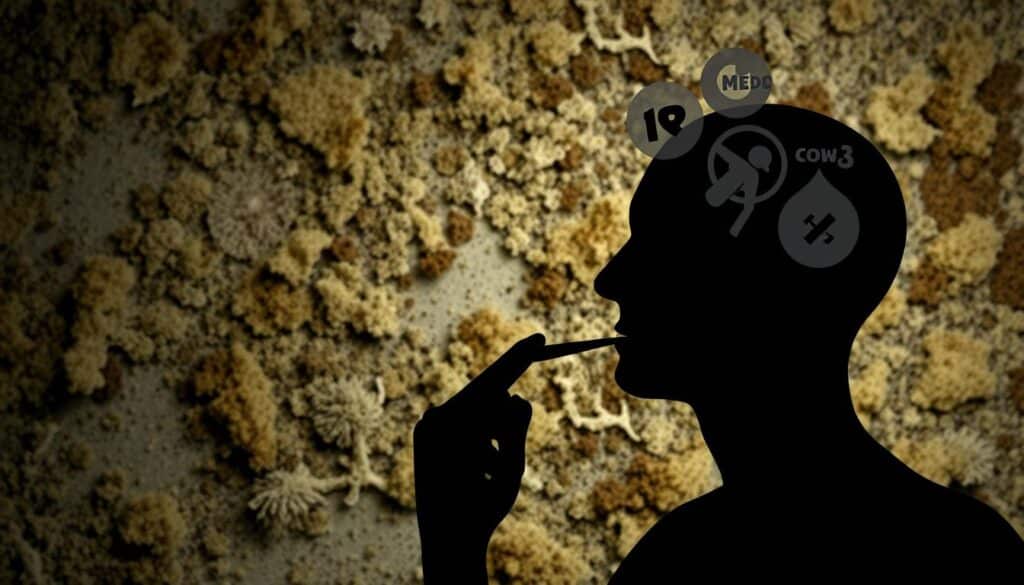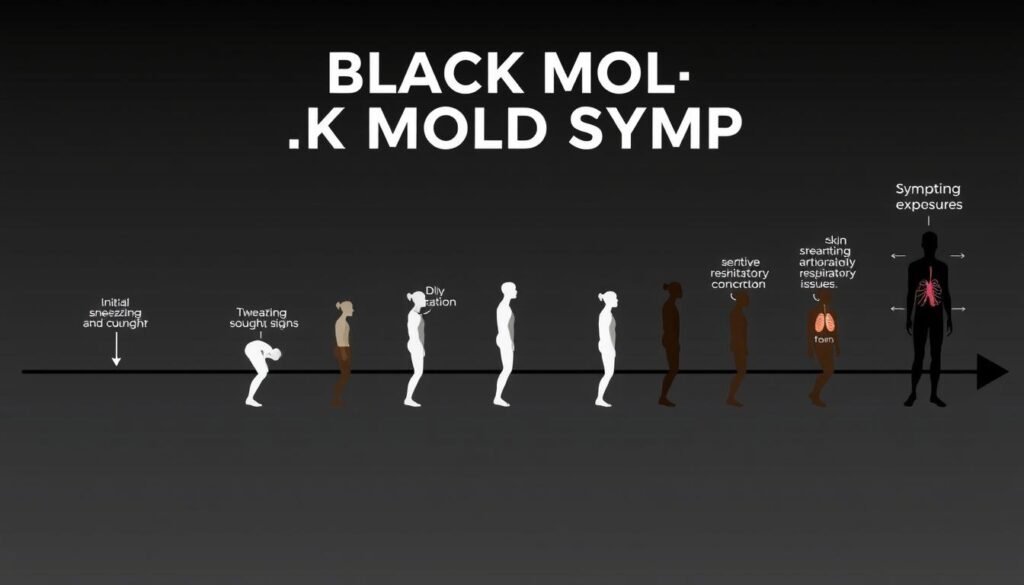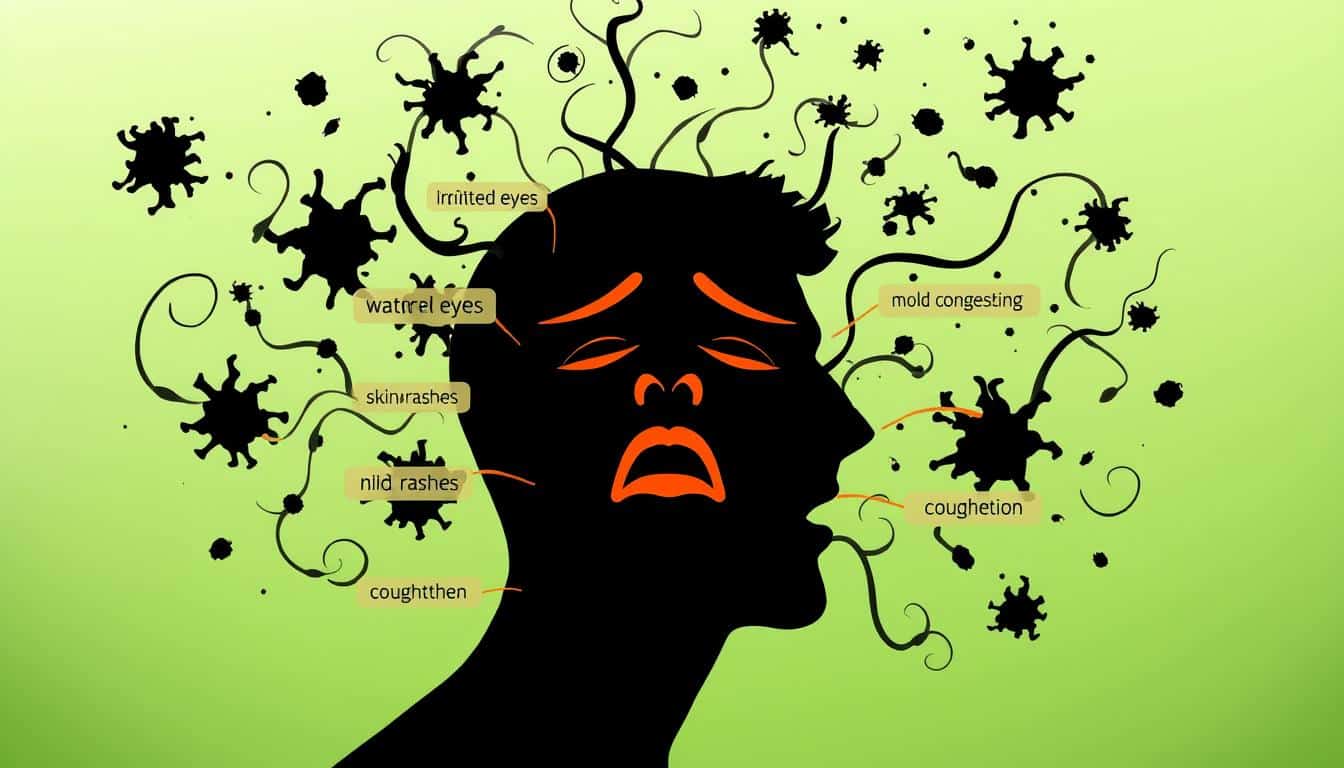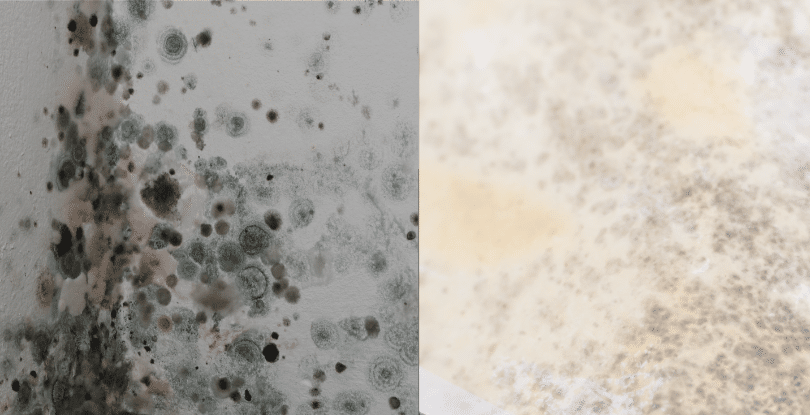Did you know millions of mold species exist? Some people get very sick from mold, while others don’t show any symptoms. Mold is a fungus that grows indoors and outdoors. Breathing in mold spores can harm your health, especially if you have allergies or a weak immune system.
It’s important to know the risks of mold exposure. If you find mold in your home or workplace, act quickly.
Key Takeaways
- Mold exposure can cause a variety of health issues, from respiratory problems to skin irritation.
- Individuals with mold allergies or respiratory conditions like asthma are at a higher risk of experiencing severe symptoms.
- Prompt mold remediation and improving indoor air quality are essential to addressing mold-related health concerns.
- Early detection and treatment of mold exposure are crucial to prevent long-term health consequences.
- Consulting with a mold remediation specialist can help identify and resolve mold issues in your home or workplace.
What is Black Mold?
Black mold, also known as Stachybotrys chartarum, grows on cellulose-rich materials like paper, wood, and drywall. It shows up as dark green or black. While it can affect those with allergies, it’s not more dangerous than other molds.
Understanding the Different Types of Mold
Many molds can grow in damp places, including Cladosporium, Penicillium, and Aspergillus, besides black mold. Black mold might look more striking, but all molds can cause health problems. This is especially true for people with allergies or weakened immune systems.
Conditions for Black Mold Growth
Black mold needs warmth and moisture to grow, often in damp or water-damaged areas. The National Institute of Environmental Health Sciences (NIEHS) says it can cause allergies and irritation. It can also make asthma or lung problems worse in those who already have them.
The CDC says rare health problems from mold in homes are uncommon. But, they suggest using commercial mold removal products and avoiding bleach mix-ups. They also advise throwing away soft or porous items with mold.
| Mold Type | Growth Conditions | Potential Health Effects |
|---|---|---|
| Stachybotrys chartarum (Black Mold) | Damp, warm environments; cellulose-rich materials | Allergies, respiratory issues, severe reactions in high-exposure settings |
| Cladosporium | Damp, cool environments; on plant materials, textiles, wood | Allergies, asthma symptoms |
| Penicillium | Damp, cool environments; on foods, textiles, building materials | Allergies, respiratory infections |
| Aspergillus | Warm, dry environments; on a wide range of materials | Allergies, lung infections, opportunistic infections in immunocompromised |
Can Black Mold Make You Sick?
Mold is a natural part of our world. Even black mold can cause health problems, especially for those with mold allergies. When mold spores are in the air, they can make people sneeze, have a runny nose, and breathe harder.
People with weak immune systems are more likely to get fungal infections from mold. This includes those with certain medical conditions or taking certain medicines.
Allergic Reactions to Mold Spores
Black mold spores can get into your body through breathing or eating contaminated food. This can make you cough, wheeze, and have a skin rash. You might also get a sore throat, nasal congestion, red or itchy eyes, and post-nasal drip.
For some, mold can make asthma symptoms worse. This can lead to shortness of breath and feeling tight in the chest.
Risk Factors for Mold-Related Illnesses
- Duration and mode of exposure to mold
- Nutritional status and hereditary factors
- Pre-existing medical conditions, such as chronic respiratory issues
- Weakened immune system functionality
Black mold isn’t always more dangerous than other types. But it can still be risky for people who are more vulnerable. To stay safe, keep your place clean, fix leaks, and use air purifiers.
If you keep getting sick after being around mold, see a doctor. They can help figure out what’s going on and how to fix it.

“Mold exposure can lead to a range of health issues, from mild allergic reactions to more severe respiratory problems. It’s crucial to take proactive steps to prevent and address mold in your living environment.”
How Harmful is Black Mold?
Black mold can be harmful, especially for those with mold allergies. But, it’s not more dangerous than other molds. The health effects depend on how sensitive you are and your immune system, not the mold type.
People with allergies or weak immune systems face more severe symptoms. Inhaling black mold spores can cause allergic reactions, asthma, and more. Symptoms include respiratory issues, fatigue, headaches, and memory loss.
Mold spores can settle in the lungs, causing infections in those with weak immune systems. Research links mold to asthma and long-term health issues. More studies are needed.
“Toxic mold syndrome” is not an official diagnosis; it refers to a constellation of symptoms like fatigue and muscle aches thought to be caused by indoor black mold exposure.
To tackle black mold risks, find and fix the moisture source. Wear protective gear when removing mold. Good ventilation, HEPA air filters, and a healthy diet can help reduce mold effects.
| Health Risks of Black Mold | Symptoms of Exposure |
|---|---|
| Allergic reactions, asthma symptoms, respiratory infections | Coughing (sometimes with blood), fever, fatigue, joint and muscle pain, headache, night sweats |
| Lung infections (especially in those with weakened immune systems) | Gastrointestinal issues, fever, chills, trouble concentrating, dry skin, stiff joints |
| Potential long-term health issues like asthma development | Sneezing, watery eyes, itching, skin rashes, swelling of the mouth or throat, difficulty breathing |
How Quickly Can Black Mold Affect You?
The time it takes for black mold symptoms to show can vary a lot. This depends on how sensitive someone is and how much they are exposed to. For those with allergic reactions to black mold, symptoms can pop up right after they breathe in the spores. But for those without allergies, it might take weeks or even months to notice any health issues.
Immediate vs. Delayed Symptoms
How fast and how bad the health effects of black mold can be different for everyone. People with weak immune systems or breathing problems are more likely to feel sick right away. They might get stuffy noses, watery eyes, and trouble breathing within hours.
But, those who are not sensitive to mold might not feel sick for a long time, even if they are exposed to it for a long time. This shows why it’s key to test the air and fix any mold problems quickly. The delayed health effects of mold exposure can be serious, causing memory loss, anxiety, and liver damage over time.

Identifying and remedying the source of mold, often caused by high humidity or water damage, is crucial in the removal process.
Being close to the mold also affects how quickly symptoms appear. The timeline of black mold symptoms varies a lot from person to person. This highlights the need to act fast to fix any mold problems and protect your health.
What Should You Do if You Breathe in Mold
Steps to Take After Mold Exposure
If you think you’ve been exposed to black mold, act fast. Move away from the moldy area and find fresh air right away. Mold spores can make you feel sick, so see a doctor if you have bad symptoms like trouble breathing.
For mold cleanup and remediation, get a pro to check it out. Trying to clean up big mold yourself can be dangerous without the right gear. Mold needs damp places to grow, so fixing the moisture problem is key to stopping it from coming back.
- Leave the contaminated area and get to fresh air
- Seek medical attention if you experience concerning symptoms
- Contact a professional mold remediation service to assess and address the issue
- Identify and fix the source of the moisture problem to prevent mold from returning
Knowing what to do after mold exposure is important for your health. Quick action and professional help can help you deal with mold in the home safely. This way, you can avoid more problems from mold.
“Mold spores can be harmful when inhaled, especially for those sensitive to mold.”
Who is Most at Risk?
Mold exposure can be very harmful, especially for some groups. Children, especially babies and toddlers, are at high risk. This is because mold can lead to asthma in young ones.
People with weak immune systems or breathing problems are also at risk. Those who have allergies in their families should be careful too.
Children and Mold Exposure
Young kids are very sensitive to mold. Their bodies are still growing, making them more vulnerable. Being exposed to mold early on can cause asthma and breathing problems.
Mold in the Workplace
Jobs in damp places can expose workers to mold. This includes farming and carpentry. Employers need to find and fix mold problems to keep their workers safe.
| Groups Vulnerable to Mold Exposure | Potential Health Risks |
|---|---|
| Infants and young children | Increased asthma risk, respiratory issues |
| Individuals with compromised immune systems | Severe allergic reactions, lung infections |
| People with pre-existing respiratory conditions | Exacerbation of asthma, allergic symptoms |
| Individuals with a family history of allergies | Higher likelihood of developing mold allergies |
| Employees in damp, poorly ventilated workplaces | Occupational exposure and related health issues |
Knowing who is most at risk helps us protect them. We can take steps to prevent mold exposure and its health effects.

Symptoms of Mold Exposure
Being around mold, especially black mold, can cause many unpleasant symptoms. Common respiratory problems include coughing, wheezing, and feeling short of breath. Skin issues like rashes or hives are also common. People might also get headaches, feel dizzy, or have other health problems, especially if they have allergies or a weak immune system.
Respiratory Symptoms
Mold spores can get into your lungs, causing irritation. You might cough a lot or wheeze, as your lungs try to get rid of the spores. Feeling short of breath is another serious symptom, as your airways get inflamed and narrow, making it hard to breathe.
Skin Irritation and Other Symptoms
Mold can also cause skin problems. You might get rashes, hives, or even eczema-like symptoms as your body reacts to mold. Headaches, dizziness, and feeling tired are other symptoms linked to mold exposure.
How bad these symptoms are can vary a lot. It depends on how sensitive you are and how much mold there is. People with asthma, COPD, or a weak immune system are more likely to get sick from mold.
| Symptom | Description |
|---|---|
| Coughing | A persistent, irritating cough that may worsen with mold exposure. |
| Wheezing | A high-pitched whistling sound during breathing, indicating airway obstruction. |
| Shortness of Breath | Difficulty breathing and feeling like you can’t get enough air, especially during physical activity. |
| Rashes | Skin irritation, including redness, itchiness, and hives. |
| Headaches | Persistent or recurrent headaches that may be triggered by mold exposure. |
| Dizziness | Feelings of lightheadedness, vertigo, or unsteadiness, which can be caused by mold-related issues. |
It’s crucial to deal with mold exposure quickly. Symptoms can get worse over time and lead to serious health problems. If you think you have mold issues, see a doctor for the right diagnosis and treatment.
Diagnosing Mold Allergies
If you think you might have a mold allergy, see a doctor for a proper check-up. Doctors usually use two tests: skin prick tests and blood tests.
Skin Prick Tests
Skin prick tests involve putting small amounts of potential allergens, like different mold types, on your skin. Then, they watch for reactions. This test shows if your body makes IgE antibodies to certain molds.
About 3-10% of people have a mold allergy. Skin prick tests can find out which molds cause the problem.
Blood Tests
Blood tests are another way to find mold allergies. They check for Immunoglobulin E (IgE) antibodies against mold allergens. This helps find the mold that causes allergic reactions.
ABPA, affecting 1-2% of people with asthma, is caused by Aspergillus mold. Blood tests can spot this condition.
Getting a correct mold allergy diagnosis is key to managing symptoms. Working with a healthcare provider helps find the right treatment for mold sensitivities.
Treatment Options for Mold Allergies
For those dealing with mold allergies, the best approach is to avoid mold as much as possible. There are many ways to manage symptoms and find lasting relief.
Medications and Therapies
Nasal corticosteroids, like ciclesonide, fluticasone, and mometasone, help with upper respiratory issues from mold allergies. Antihistamines such as loratadine, fexofenadine, and can stop itching, sneezing, and a runny nose by blocking histamine.
For serious cases, doctors might suggest immunotherapy, or allergy shots or tablets. This treatment helps the body get used to mold allergens, making symptoms less severe over time.
Self-Care Strategies
- Keep indoor humidity below 50% with a dehumidifier to stop mold growth.
- Fix any water leaks or moisture issues in your home to reduce mold exposure.
- Make sure indoor spaces have good ventilation to prevent mold buildup.
- Regularly clean and maintain air conditioning units and other mold sources.
- Use a certified asthma and allergy friendly air filter to catch mold spores.
- Try nasal lavage, or rinsing your nose with salt water, to ease nasal symptoms.
By using the right medicines, therapies, and self-care, people with mold allergies can manage their symptoms well. This helps them stay healthier overall.
Conclusion
Breathing in mold spores, like those from black mold, can be harmful. It’s especially risky for people with mold allergies or weak immune systems. Knowing the signs of mold exposure and taking steps to stop it is key.
It’s important to be aware of mold risks and how to prevent them. This way, you can keep your air clean and your health safe. Understanding mold risks helps protect you and improves your indoor air quality.
Mold is a big problem, affecting 47% of U.S. homes and 45% of U.S. office buildings. Being exposed to mold can cause allergic reactions, from sneezing to serious breathing problems. Testing for allergies can show sensitivities, and treatments can help manage symptoms.
Preventing mold is crucial for a healthy indoor space. This means fixing moisture issues quickly and stopping mold from growing. By being proactive, you can protect your home, workplace, and health from mold dangers.
FAQ
What is black mold and what are the conditions for its growth?
Black mold, also known as Stachybotrys chartarum, grows on cellulose-rich materials like paper, wood, and drywall. It shows as dark green or black. It thrives in warm, moist environments, often found in damp or water-damaged areas.
Can black mold make you sick?
Yes, black mold can make people sick, especially those with mold allergies. Mold spores can cause allergic reactions, leading to symptoms like sneezing and respiratory issues. People with weakened immune systems are at higher risk of fungal infections.
How harmful is black mold compared to other types of mold?
Black mold isn’t inherently more dangerous than other types. Health effects depend on individual sensitivity and immune strength. Those with allergies or weakened immunity are more likely to experience severe symptoms.
How quickly can black mold affect you?
The impact of black mold varies by individual. Those with mold allergies may show symptoms immediately. Others might not experience symptoms for a long time. The severity and speed of effects depend on personal biology and susceptibility.
What should you do if you suspect you have been exposed to black mold?
If you suspect black mold exposure, act quickly. Move away from the area and seek fresh air. See a doctor if symptoms like respiratory distress occur. For cleanup, hire a professional to avoid risks without proper gear.
Who is most at risk for health issues from black mold exposure?
Certain groups face higher risks from mold exposure. Children, especially young ones, are more susceptible due to increased asthma risk. Those with weakened immune systems, respiratory issues, or allergies are also at risk. Workplaces with poor air quality can also pose health hazards.
What are the common symptoms of mold exposure?
Mold exposure can lead to respiratory issues like coughing and wheezing. Skin irritation, headaches, and dizziness are also symptoms, especially for those with allergies or weakened immunity.
How are mold allergies diagnosed?
Doctors use skin prick tests or blood tests to diagnose mold allergies. Skin prick tests apply allergens to the skin to monitor reactions. Blood tests check for IgE antibodies specific to mold, indicating an allergic response.
How are mold allergies treated?
Treatment for mold allergies includes avoiding exposure and using medications like nasal corticosteroids. Immunotherapy, or allergy shots, can be effective for some. Keeping spaces well-ventilated and using dehumidifiers can also help reduce exposure.




